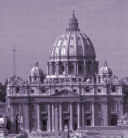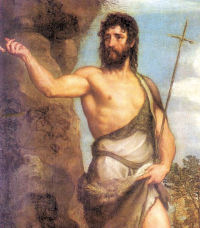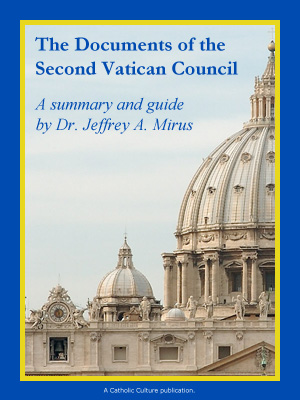Advent: December 12th
Third Sunday of Advent; Our Lady of Guadalupe
Other Titles: Day 1 O Antiphons: O Sapientia (O Wisdom)
» Enjoy our Liturgical Seasons series of e-books!
"Rejoice: the Lord is nigh." As Christmas draws near, the Church emphasizes the joy which should be in our hearts over all that the birth of our Savior means for us. The great joy of Christians is to see the day drawing nigh when the Lord will come again in His glory to lead them into His kingdom. The oft-repeated Veni ("Come") of Advent is an echo not only of the prophets but also of the conclusion of the Apocalypse of St. John: "Come, Lord Jesus," the last words of the New Testament.
Today is known as Gaudete Sunday. The term Gaudete refers to the first word of the Entrance Antiphon, "Rejoice". Rose vestments are worn to emphasize our joy that Christmas is near, and we also light the rose candle on our Advent wreath.
This is the 250th anniversary of Our Lady of Guadalupe declared as the Patroness of Mexico. In Mexico and other areas this feast is celebrated today. In 1910 she was declared Patroness of Latin America, and in 1945 Pope Pius XII declared Our Lady of Guadalupe to be the Empress of all the Americas. She appeared to an Indian convert named Juan Diego on December 9, 1531. She left a marvelous portrait of herself on the mantle of Juan Diego. This miraculous image has proved to be ageless, and is kept in the shrine built in her honor, the Basilica of Our Lady of Guadalupe.
The first reading is taken from the book of Isaiah 35:1-6, 10 in which the Prophet speaks of the liberation of the Jews from the Babylonian exile and foreshadows the coming of the Messiah to liberate the human race.
The second reading is from the letter of James 5:7-10. St. James addresses this letter to Jewish converts to Christianity living outside of Palestine. The theme deals with the second coming of Christ.
The Gospel is from St. Matthew 11:2-11. The Church brings John the Baptist, the man who prepared the people for Christ's public mission, before our minds today, as an example that we should follow, even if only from afar. John prepared himself for the task of welcoming and introducing Christ to others by a life of self-mortification and penance. He told the people that the first essential for meeting Christ, and profiting by his coming, was that they should turn away from sin and give up any evil ways which hitherto they had followed. He himself practiced what he preached and his preaching, therefore, bore fruit among many of his hearers. Four of the twelve Apostles became followers of Christ because of the Baptist's example and preaching.
John is calling on us too today, to prepare ourselves for Christ's coming this Christmas by turning away from sin, and by the mortification of ourselves in many ways. We are not expected to wear the rough camel-hair dress he wore, or to eat nothing but locusts and wild honey. But each one of us can restrain the excessive luxuries of the palate, in which we often indulge, and use the money, thus saved, to help those who are short of the necessities of life, in far too many parts of today's world. Many of us, too, could look through our wardrobes and find garments we can well do without. These could help to keep the wintry blasts from our poor, shivering fellowmen or women this Christmas.
Most of us feel touched, when we see the Baby Christ lying, half-naked, on the rough straw in the stable. But to do something for him, we need not wish we were there on that first Christmas. We can do it for his suffering brothers this Christmas, and he himself tells us if we do that we are doing it for him.
In repenting of our sins, the first necessary step if we want to welcome Christ into a pure heart and into our Christian homes is to let our conversion and resolutions be firm, as was the resolute stand of John the Baptist. He was not a reed that was shaken by every wind, and we too must stand firm against the temptations of the world, the flesh and the devil, if we are to remain worthy of the name of Christian. John the Baptist suffered martyrdom for his faith and convictions. Few, if any, of us will be called on to lay down our lives for our faith, but we are all called on to live for it, and with it, every day of our lives.
This may demand sacrifice nowadays, when our permissive society derides and looks down on those still trying to live according to the old-fashioned ten commandments. But we must not only be ready to accept this derision; we must do all in our power, by word, prayer and example, to get our erring neighbor to see that virtue does pay in the end.
We have much in this story of John the Baptist which should help us to welcome Christ properly this Christmas. Think of the Baptist today, and listen to the message he has for you. If you do your best to put it into practice, the good, merciful Lord himself will do the rest for you. He came to save sinners. He came to save you. If you cooperate and do your part, you will hear, on your judgment day, the joyful words of Christ : "You are more than a prophet, you are a citizen of heaven—a saint."
![]()
Our Lady of Guadalupe
"Hear me and understand well, my son the least, that nothing should frighten or grieve you. Let not your heart be disturbed. Do not fear that sickness, nor any other sickness or anguish. Am I not here, who is your Mother? Are you not under my protection? Am I not your health? Are you not happily within my fold? What else do you wish? Do not grieve nor be disturbed by anything."
— Our Lady to Juan Diego
In the winter of 1531, a poor, 57-year-old Aztec Indian living five miles outside of Mexico City encountered a miraculous happening on his way to morning Mass. First he heard strange music coming from Tepeyac Hill, and then he heard a woman's voice calling his name. Juan Diego climbed the hill and encountered a young woman, appearing to be of his own people in physical appearance and dress. The woman identified herself as the Virgin Mary, and told Juan Diego to ask the bishop of Mexico City to build a church on the hill to assist in the conversion of the nation and be a source of consolation to the people.
Juan Diego obeyed the request, but the bishop was skeptical regarding the message, even though he perceived that Juan was a humble, and well meaning Catholic. Juan reported the bishop's doubt to Our Lady at Tepeyac Hill, and she asked him to return to the bishop once again, bearing the same message. The bishop once again heard the story, and told Juan Diego to ask Our Lady for a sign that it was indeed herself that wished for the church to be built.
When he returned to the hill, Mary gave Juan Diego such a sign. Miraculously, roses appeared on the hill in the middle of winter, and Juan gathered them in his tilma, or cloak. Our Lady arranged the roses in his tilma with her own hands, and Juan returned to the bishop's presence. When Juan released the tilma, allowing the flowers to fall to the floor, it was revealed that a miraculous image of Our Lady had imprinted itself on his tilma (see above).
The bishop immediately fell to his knees, and came to believe in Juan Diego's message. A church was built on the spot of the apparition, as Mary had requested, and 8 million people converted to Catholicism in a short period of time upon hearing of or viewing the miraculous image of Our Lady.
The tilma of Juan Diego has been the subject of much modern research. The tilma, woven out of coarse cactus fiber, should have disintegrated after 20 years, but although over 500 years have passed the tilma is still in perfect condition. The pupils of Mary in the picture reflect the Indians and clergy present at the time of the first revelation of the image. No paint was used, and chemical analysis has not been able to identify the color imprint. Additionally, studies have revealed that the stars on Mary's mantle match exactly what a Mexican would have seen in the sky in December of 1531.
Patron: The Americas; pro-life movement.
Things to Do:
- Start a novena to Our Lady of Guadalupe.
- If you live close to La Crosse, WI visit the beautiful Shrine of Our Lady of Guadalupe if not make a virtual visit.
- Read more about this title of Our Lady.
- Make a sacrifice, say a prayer or visit the Blessed Sacrament for an end to abortion.
- If your parish is having a pro-life Mass or holy hour try to attend.
- Have a party, which includes a procession and a special Mexican dinner to celebrate the feast.
Advent Reflection: Stepping Out of the Night
What is Advent? Many answers can be given. We can grumble and say that it is nothing but a pretext for hectic activity and commercialism, prettified with sentimental clichés in which people stopped believing ages ago. In many cases this may be true, but it is not the whole picture.
We can also say that Advent is a time when a kindness that is otherwise almost entirely forgotten is mobilized; namely, the willingness to think of others and give them a token of kindness. Finally we can say that Advent is a time when old customs live again, for instance, in the singing of carols which takes place all over the country. In the melodies and the words of these carols, something of the simplicity, imagination and glad strength of the faith of our forefathers makes itself heard in our age, bringing consolation and encouraging us perhaps to have another go at that faith which could make people so glad in such hard times.
This latter kind of experience of Advent brings us quite close to what the Christian tradition has in mind with this season. It has expressed its view of Advent in the Bible texts which it took as the season's signposts. I will mention just one of them, a few verses from Paul's letter to the Christians in Rome. There he says, "... it is full time now for you to wake from sleep...the night is far gone, the day is at hand. Let us then cast off the works of darkness and put on the armor of light, let us conduct ourselves becomingly as in the day, not in revelling and drunkenness, not in debauchery and licentiousness, not in quarrelling and jealousy. But put on the Lord Jesus Christ..." (Rom 13:11-14).
There are many people, of course, who urge us to get up and awake; "Germany, awake!" was the cry of those who, years ago, were bent on deluding the nation; and today too there are awakenings and uprisings that lead further into darkness instead of out of it. What does Paul mean? He puts very clearly what he means by "night" by speaking of "revelling and drunkenness, debauchery, licentiousness, quarrelling and jealousy."
For Paul, nocturnal revelling with all that goes with it stands for the dark side of human nature, man's being "asleep". For him it becomes a symbol of the pagan world as such, submerged in material things, held fast in the darkness that prevails where there is no truth and which, despite all its decibels and hectic activity, is asleep, because it lives unaware of genuine reality, of the real human vocation.
Nocturnal orgies as the image of a world in ruin—are we not appalled to see how aptly Paul characterizes our present times, which are returning to paganism? For us, "rising from sleep" means arising from conformity with the world and with the times and having the courage to believe and to shake off the dream that causes us to bypass our true vocation and our best possibilities. Perhaps the Advent hymns we hear every year may be lights to us, indicating our path, making us look up and recognize that there are greater promises than those of money, power and pleasure. Being awake for God and for other people—that is the kind of "waking" that Advent has in mind, the wakefulness which discovers the light and brightens the world.
—Joseph Cardinal Ratzinger, Seek That Which is Above

Third Sunday of Advent, Guadete Sunday
Station with San Pietro in Vaticano (St. Peter's in the Vatican):
The Station is at St. Peter's in the Vatican. After the two great basilicas chosen for the first and for the second Sunday in Advent, we come to St. Peter's in the Vatican, a church which shares with the Lateran the chief feasts of the year. It was selected as the station for today, because on this Sunday occurred the final scrutiny or examination of those candidates preparing for the Ordinations usually held on Ember Saturday in December. The original basilica was built by Constantine in 323 over the place where St. Peter was buried.
For more on San Pietro in Vaticano, see:
For further information on the Station Churches, see The Stational Church.






